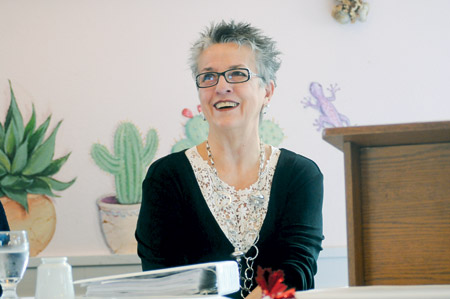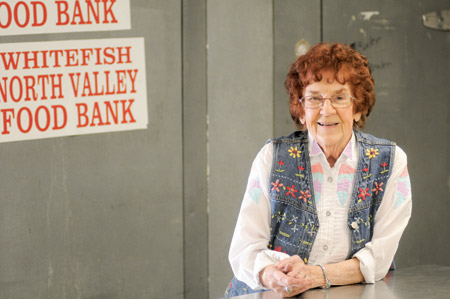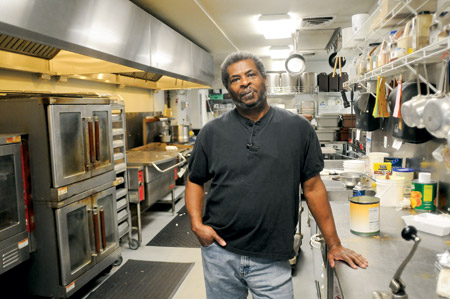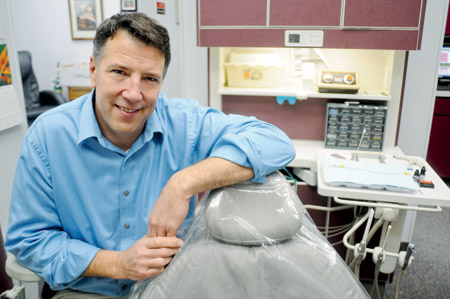When we look at the holiday season with clear eyes, amid all of the shopping frenzies and frantic planning, we recognize that the true spirit of the season is compassion – giving and sharing with friends, family and neighbors.
There are many people in our community who embody that spirit. We’ve selected four to feature in this week’s Beacon.
By sharing their stories with our readers, we hope to offer our gratitude for everything they do. They remind us everyday of what compassion can do for a community.
KAY HOPKINS
 |
|
Kay Hopkins leads a recent Lakeside Community Club meeting at Vista Linda restaurant in Somers. – Lido Vizzutti | Flathead Beacon |
SOMERS – Last week, a powerful force gathered at the Vista Linda restaurant here. The women politely filed in, one at a time and in pairs, and took their seats. By the time lunch was served, roughly 70 members of the Lakeside Community Club were all in one place, talking about their recent accomplishments and setting agendas.
One thing was certainly clear: These ladies get things done.
And leading them for the past two years has been club president Kay Hopkins, a Lakeside resident for 12 years, and all of them spent involved with the LCC.
The meeting began in an orderly fashion, with the Pledge of Allegiance and a call to order. Soon, Hopkins was announcing the names of the club members who celebrate their birthday in November, followed by a round of applause.
“Oh, they don’t get by with a hearty hand clap,” Hopkins said, and launched into a rousing rendition of “Happy Birthday to You.”
Before living in Lakeside, Hopkins, 64, was an avid member of the Kalispell community, serving as the director of Flathead CARE and the president of the Flathead High School booster club. She was also honored as the United Way’s Volunteer of the Year in 1995.
The urge to volunteer and get involved began at a young age, Hopkins said, because she was raised in the small town of Charlo. That was the way people got to know one another, she said, adding that all things are possible in small communities due to the energy of the people who live in them.
When she and her husband Ron, who are the parents of one son and a set of twin daughters, moved to the lake, she had no intentions of sitting on the sidelines of her new community.
“You can reside here or you can live here,” Hopkins said before the LCC meeting began. “I choose to live here.”
For Hopkins and the other members of the club, really living means bettering the lives of others. The LCC is a 100-year-old organization with about 130 members – all women – known for its annual summer Community Fair, which raises thousands of dollars for local nonprofits.
The ladies work year-round on the Community Fair, Hopkins said, and it pays off. At the most-recent meeting, club members learned that they raised and will give away nearly $27,800 to more than a dozen nonprofits, including the Lakeside QRU and ALERT.
Other club projects include painting customized giant snowmen to line U.S. Highway 93 through Lakeside and Somers; planting flowers in the summer; and donning the trees with red bows.
“It’s so active,” said club vice president Barbara Bates of the LCC.
With so much going on, keeping everything organized can be a challenge. Hopkins has been more than up to the task in her two-year tenure as president, Bates said.
“She really keeps things right on track and is open to new ideas,” Bates said.
Hopkins, like most good leaders, is quick to praise the club’s members and their cumulative effort and said it takes a huge amount of energy and dedication to pull of an event like the Community Fair.
“It certainly isn’t just me,” Hopkins said.
At the Nov. 13 meeting, the members voted on new club administrators, who are set to take over in December. And regardless of her title in the club, Hopkins vows to remain as active as ever and continue serving her community.
“I love the people, I love the interaction,” she added. “I can’t just sit in the house and not get involved.”
– Molly Priddy
JUNE MUNSKI-FEENAN
 |
|
June Munski-Feenan is seen at North Valley Food Bank in Whitefish. – Lido Vizzutti | Flathead Beacon |
“Just make sure you have enough for everybody,” June Munski-Feenan says, directing a room crowded with volunteers and mountains of donated food. While bouncing from one conversation to another, she doesn’t skip a beat explaining the overwhelming supply and demand at the North Valley Food Bank in Whitefish.
It’s Thursday afternoon, a week before Thanksgiving, and the unassuming house on East First Street, the longtime home to one of the largest food banks in western Montana, is buzzing.
The holidays can be a frantic time of year for everyone, but especially for organizations like the North Valley Food Bank that embody the giving spirit of Thanksgiving and Christmas.
At 85 years old, Munski-Feenan is the vivacious leader of a team of almost 50 volunteers. Last week they were scrambling to organize roughly 200 baskets of food and other items to supply to families for Thanksgiving. Last year they gave over 343,000 pounds of food and other necessities to more than 7,000 families across the valley. They provided school supplies, including backpacks and notebooks, to 87 kids. Every winter they hand out coats, gloves and other warm gear.
The Flathead Valley consistently has the third largest homeless population in the state, according to the 2011 Montana Homeless Survey, sponsored by the state’s Department of Public Health and Human Services. There is also a consistently high number of families living near or below the poverty line, according to local surveys.
“This is important,” Munski-Feenan says, looking across the flurry of activity. “It’s necessary. We don’t turn anybody away.”
Thirty-four years after founding the food bank, Munski-Feenan still has her sleeves rolled up.
“These girls are all busy so you got to jump in and do what needs to be done. You can’t just sit back,” she says, pointing at the other volunteers.
“It’s not a hard job. I have to get up and keep going. I never sit around. I like to do things. My doctor’s amazed.”
Aside from staying involved in the day-to-day operations, Munski-Feenan is also the food bank’s tenacious advocate throughout the community, constantly championing the cause she and others firmly believe in.
“She has more energy than all of us put together,” says Natalie Priebe, a volunteer at North Valley. “She is totally committed. I don’t know how she does it.”
Munski-Feenan, a lifetime resident of the Flathead Valley from Columbia Falls, was supposed to be retiring 34 years ago after a long career as a dental assistant and office manager. Then a friend handed her 100 loaves of bread and asked if Munski-Feenan knew a way to share them with people in need. She didn’t. So she found a way.
She started the Whitefish Food Bank, a nonprofit 501(c)(3) corporation that eventually became the North Valley Food Bank, in her garage. She and a few close friends began handing out fresh produce, canned goods and bread.
The operation quickly grew too big for her garage. The Soroptimist Club of Whitefish donated land and a group of individuals donated an old house that could be relocated, and the North Valley Food Bank moved into its current setting in 1985.
Today the 3,000-square-foot, 80-year-old makeshift facility is again overflowing with donations.
That’s why Munski-Feenan is on her biggest fundraising campaign ever. The food bank has plans for a new facility at Baker Commons south of town. The organization and board of directors have been trying to raise $1.5 million to build the new 4,800-square-foot facility and establish a healthy endowment fund. Munski-Feenan estimates that they still need $600,000 in order to break ground next spring.
The new food bank, which would include a kitchen and ample space for storing and delivering truckloads of donations, would allow the organization to help more people more efficiently, Munski-Feenan says. City architecture standards required some decorative designs for the new site, but the features, like rock siding, are being donated, she says.
“We could get by in a tin shack, because our people are good at doing this and they don’t need something fancy,” she says. “But that’s what the city required.”
The support of the community has been tremendous, she says, and it continues to amaze her. Just last week the Whitefish Community Foundation gave out $345,000 to local nonprofit organizations, including $42,000 to North Valley Food Bank.
“We’ve got a lot of people here who aren’t just thinking about themselves,” Munski-Feenan says.
She says this fundraising effort will be her last stand. Call it a second retirement, although she doesn’t plan on sitting still. She’s already thought of enjoying some fishing and hiking.
“It’s time to let some new blood come in with new ideas,” she says.
“But,” she adds with a wry smile, “I’ll still be around (the food bank) to antagonize them.”
For more information about the North Valley Food Bank, including volunteering and donation opportunities, call 862-5863 or visit www.northvalleyfoodbank.org.
– Dillon Tabish
JOHN TAFT
 |
|
John Taft is seen in the Agency on Aging kitchen in Kalispell. – Lido Vizzutti | Flathead Beacon |
To some he’s a “hard worker” and a “legend,” but John Taft simply thinks of himself as Flathead County employee No. 468.
Taft says there are not many people who still work for the county who have a three-digit employee number. And he’s probably right. Taft has been a cook for Meals on Wheels in Kalispell since 1978. In his 34 years on the job, he has prepared more than 2 million meals for Flathead County’s senior citizens.
The Meals on Wheels program was first established in Kalispell in 1970, when it was run out of a church basement. Today it falls under the umbrella of Flathead County’s Agency on Aging. According to program manager J.R. Isles, the kitchen prepares about 300 meals each day.
Some are served in the small dining hall just south of town, while others are shipped out to the surrounding communities and delivered to people’s homes. On average, Meals on Wheels makes about 75,000 dinners annually. In return, the agency asks for a small donation.
Preparing almost all of those meals is Taft, a soft-spoken, 61-year-old native of New Jersey. Taft first came to the Flathead Valley in 1973, when he was a cook and storeroom clerk for a U.S. Air Force radar base in Lakeside. Back then, at the height of the Cold War, the small facility was keeping an eye on the skies for Soviet missiles. It closed in the 1980s. In 1978, Taft left the Air Force and began looking for work, deciding to stay in Montana so he could continue to fish and hunt. In October of that year he got a job in the small Meals on Wheels kitchen. He has been there ever since.
It was in that very kitchen that Taft was boxing frozen meals on Wednesday afternoon last week. With his glasses perched low and a toothpick jerking side-to-side in his mouth, Taft wrote the meal’s contents on top of each box cover: spaghetti, Italian vegetables and a garlic roll.
Taft’s day usually starts around 8 a.m., when he begins preparing meals. Around 11 a.m., the first home delivery dinners go out the door and an hour later, 30 to 50 seniors come by to eat lunch. With just one cook and one baker, the mornings get pretty busy.
“Sometimes it is, sometimes it really is. You don’t have a minute to spare, you’ve always got to be a minute ahead,” he said. “(But) I prefer it when things are busy, because then I’m not watching the clock.”
Taft enjoys talking to the seniors, especially the old cowboys who share their stories. He has also learned quite a bit about people’s dietary desires. One surprise: the popularity of liver and onions. Taft says the secret is keeping the meat moist. When it’s on the menu, the dining room fills up.
“Liver is one of those things that either you love or you hate – there is no in between,” he said.
Isles has managed the kitchen and dining hall for 19 years but still considers himself a “rookie” compared to Taft. Isles says that the 34-year veteran of the kitchen is the perfect employee and dedicated to his job and the people he serves.
For Taft, he says even after more than three-decades in the kitchen, his job is still rewarding.
“This job touches a lot of people and we get all sorts of cards and thank yous,” he said. “Cooking has always been a joy because I know a lot of people rely on these meals.”
How many more years Taft stays in the kitchen is unknown. He’s in good health and feels like he could keep cooking for another five years.
“Maybe then I’ll hang up my spurs,” he said.
– Justin Franz
DR. TOM PITTAWAY
 |
|
Dr. Tom Pittaway is seen at his dental office in Kalispell. – Lido Vizzutti | Flathead Beacon |
At around 4 a.m. on a cold December morning, a line of people began forming in the dark outside of Dr. Tom Pittaway’s dental office. It was undoubtedly a curious sight for downtown Kalispell, a situation born out of need and toothaches and broken smiles. Say the words “free dental care” and those kinds of lines will form anywhere on any day at any hour.
Pittaway has held additional free dental clinics since that first one in December 2009, though he usually schedules them before winter now. The idea of pairing the event with Christmas was admirable in theory, but chilly in practice. The free clinics are an expression of Pittaway’s samaritan philosophy toward dentistry, and life in general.
“The most powerful thing in the world is love,” Pittaway said from his office last week, while adding a sentiment he thinks he might have seen on a bumper sticker but aptly describes his own principles: “Think globally, act locally.”
“There are a lot of people here locally who are struggling. Dentistry is expensive and hard to afford. This is one way to get rid of a toothache for somebody or fix those decayed teeth that have been preventing somebody from getting a job.”
Pittaway has been a dentist in Kalispell since 1993 and runs a practice at 124 First Ave. W. His older brother John is also a dentist at the practice. Their office’s mission statement reads: “It is our desire to enhance the health and lives of everyone we have the privilege to serve and to help the people in our community.” When Pittaway reads it, he emphasizes the word “help.”
Currently Pittaway is in the process of rebranding his practice as “One Dental Center” and has plans to open a new facility in south Kalispell that will complete the One Dental Center transition, in terms of both physical geography and philosophical values. The “One” represents unity – the type of unity and neighborly goodwill he would like to see more of in his community and elsewhere.
“I’d like to build that practice and then start a whole movement,” he said.
Pittaway still has a business to run and bills to pay, but he tries to give back to his community as often as he can, through the free clinics, food and toy drives, Halloween candy buybacks, free pancake breakfasts, and contributions to organizations like Salvation Army and food banks.
He also holds “good deed contests” in which kids do a good deed in their community and then write an essay about it. Pittaway reviews the essays and, after verifying the deed, selects a winner. The winners receive prizes such as a computer or an iPad. One kid was rewarded for extensive volunteering at a food bank.
At the free dental clinics, the Pittaways and their staff donate their time and skills for a full day. The last one served 72 people on a first-come, first-serve basis – hence the early-morning lines. If the services weren’t donated, they would have cost $26,000, Pittaway said. Dr. David Weber, an oral surgeon, also lends his expertise at the clinics.
“We try to get through everybody and fix everything we can,” he said.
But Pittaway’s aspirations to serve the community go beyond holding periodic free events. He also strives for his everyday service to be first-rate and constantly evolving, so his paying customers feel comfortable knowing that they’re receiving the best dental care available.
That’s why, after already establishing a successful practice, he decided to train at the renowned Kois Center in Seattle, a program that teaches the latest advances in esthetics, implant and restorative dentistry. He has been awarded a “distinguished mentor” designation by the Kois Center. And it’s why he has taken education courses on sleep dentistry to learn more about recognizing and treating obstructive sleep apnea.
“We have all this technology but we don’t use it for good,” Pittaway said. “We have TV, but it just has a lot of useless things. I feel that we need a little more honesty and truth in the world.” For more information, visit www.onedentalcenter.com.
– Myers Reece